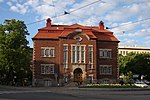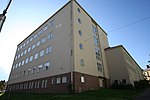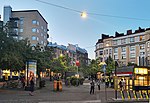Harju, Helsinki
Quarters of HelsinkiSouthern Finland Province geography stubs

Harju (Swedish: Ås) is a quarter of Helsinki, Finland. It is located northeast from the city centre, part of Alppiharju neighbourhood, between the quarters of Alppila, Torkkelinmäki, Linjat and neighbourhoods Sörnäinen and Vallila. Harju has a population of 7,237 (as of 1 January 2005) and an area of 0.27 km².Harju has the highest population density per km² in Finland, along with the neighboring Torkkelinmäki quarter. Apartments in Harju are usually very small, single-person flats. Harju also contains dozens of pubs, fast-food restaurants and Thai massage parlors, despite its very small size by area.
Excerpt from the Wikipedia article Harju, Helsinki (License: CC BY-SA 3.0, Authors, Images).Harju, Helsinki
Vaasankatu, Helsinki Alppiharju (Central major district)
Geographical coordinates (GPS) Address Nearby Places Show on map
Geographical coordinates (GPS)
| Latitude | Longitude |
|---|---|
| N 60.188327 ° | E 24.953095 ° |
Address
Vaasankatu
00510 Helsinki, Alppiharju (Central major district)
Finland
Open on Google Maps











